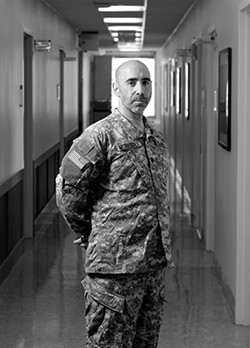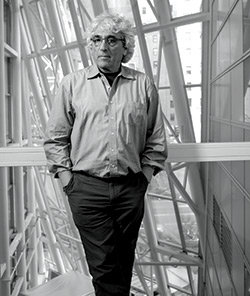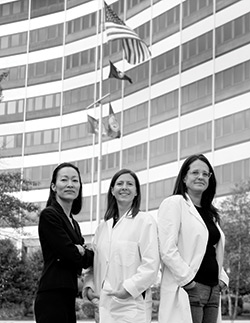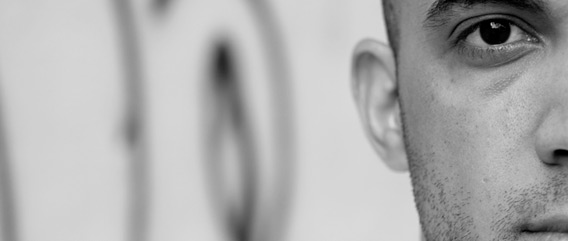Veterans Among Us
On a cold Sunday in February 1942, 50 doctors and 105 nurses from New York’s Presbyterian Hospital reported to Fort Meade, Md., to begin basic military training. At the request two years earlier of the Army Surgeon General, the group had assembled to form the 2d General Hospital, a medical unit that could be deployed overseas. The 2d General sailed to England in the summer of 1942 to convert a specialty hospital outside Oxford into a general hospital for both British and U.S. soldiers. Two years later, the unit advanced to the front lines in France, establishing a 1,000-bed tent hospital and then advancing as the front moved east. By the end of the war, Presbyterian Hospital practitioners had cared for 32,000 patients in the field.
Seventy years later, the P&S connection to the military has taken a different form: the presence of veterans—from conflicts ranging from World War II to Iraq and Afghanistan—not only as patients, but also as medical students and faculty members. As a university, Columbia welcomes and supports the 560 self-identified veterans among the student body in undergraduate, graduate, and professional schools. Columbia, including P&S, participates in Joining Forces, a federal initiative to provide employment, education, and health services for returning veterans. In addition, Columbia’s Office of Military and Veteran Affairs coordinates programming and resources to support student veterans and their families and to help bridge the gap between students who have served in the military and the majority of their peers who have not.
 Elvis Camacho’17
Elvis Camacho’17One student who has served is Elvis Camacho’17, who traces the path to his enrollment at P&S directly back to the U.S. Marine Corps. In 2004, on the trailing edge of a turbulent childhood and adolescence in Puerto Rico and Miami, Mr. Camacho, then 17 years old, decided to enlist. “When I was in high school I did not have any direction, work ethic, discipline, and I definitely did not have any confidence,” he says. “The Marine Corps, especially when I was in the infantry, made me grow up quick and helped me to strengthen many of my weaknesses, weaknesses that would have made me fail out of school a long time ago. There is no way that I would have ever been ready to study eight to 10 hours a day without having gone through the military.”
Mr. Camacho’s military service did not just instill that work ethic; it was what ultimately pointed him toward medical school, a 180-degree pivot for someone who had never even considered going to college. From the ages of 17 to 22, Mr. Camacho was stationed in nine different countries and served in combat just outside Fallujah in Iraq. Yet it was a noncombat experience—at a posting in Okinawa, Japan—that became the turning point, when Mr. Camacho volunteered at a hospital. “The exposure, the environment, talking to physicians who were formally enlisted, it all helped to orient me toward medicine,” he says. “I also had the privilege of being deployed with great corpsmen, which is our version of a medic.”
Some of those medics, once they returned to the United States, received medals for their exceptional courage, the way in which they combined medical service and service to country; that dual role had a powerful influence on Mr. Camacho. “Our corpsmen did everything that the other infantrymen were doing, and they also had the added responsibility of taking care of us,” he says. “Through many different interactions, I had this intuitive feeling that was drawing me to become a physician; it became stronger and stronger until I decided not to reenlist and to pursue my goals instead.”
At Columbia, Mr. Camacho feels the impact of his military training on his studies every day. “As a young Marine, it was hard to understand why we were always getting yelled at and told to pay attention to detail. But then I quickly realized that small details can make an incredible difference,” he says. “I try to take my education as seriously as possible, because I know that one day I may be in a position where a person’s life will be in my hands, and if I didn’t utilize my time here properly it could have serious consequences.”
Mr. Camacho does not believe that his status as a veteran sets him apart from his fellow medical students. “One of the main reasons I fell in love with Columbia was because of the diverse student body. So many people come from so many different backgrounds that I am just another individual with a typical nontraditional story,” he says. “The fact that I go to school with students who were professional ballet dancers or currently play piano on Broadway or at Carnegie Hall or have spent a great deal of time in South Africa helps me to see things from different perspectives.
"When I talk to students about my military experience, it’s always about respect. Don’t look down on folks who have taken the military option. Pay attention to how people have suffered on your behalf, in the name of defending the country. It’s about respect and understanding where they’re coming from and what got them there." — Nicholas Morrissey, MD
The United States has more than 20 million veterans today. Ten percent are female; 44 percent are over the age of 65. Of New York state’s 886,000 veterans, the largest groups are from the Vietnam War, peacetime enlistment, and the more recent conflicts in Kuwait, Iraq, and Afghanistan. Veterans have always come home with significant physical injuries, trauma, or both: Nearly 9 million veterans are currently enrolled in the Veterans Affairs (VA) health care system nationwide, which counted more than 6 million unique patient visits in 2013. Almost 4 million vets are disabled, and nearly 700,000 have received compensation following a diagnosis of post-traumatic stress disorder (PTSD).
While P&S has both medical students and faculty members who have served in the military, veterans present in the greatest numbers as patients. Their most common injuries include traumatic brain injury (TBI), PTSD, limb loss, spinal cord injury, and burns. Particularly due to the prevalence of blast injuries in the most recent conflicts, some veterans also have polytrauma—simultaneous injuries to multiple body parts or organ systems—and require even more complex levels of care.
“It’s really hard to quantify polytrauma, but I’ve seen it be a very devastating thing to people’s personal lives,” says Nicholas Morrissey, MD, associate professor of surgery and a lieutenant colonel in the Army Reserve Medical Corps. “The system is designed to address individual diagnoses. But some of the signs of TBI or PTSD are very subtle, so if you take someone who’s got a TBI from a blast along with PTSD, sometimes it’s hard to distinguish between the two. And if you combine PTSD with TBI with extremity trauma, then you have a patient in their 20s who has a lifelong polytrauma to deal with, and there’s a big psychological component on them as well as on their families. You’re dealing with a patient, and maybe a young wife, who are trying to figure out what the hell happened, what’s going on here; it’s sometimes hard to come up with a real diagnosis.”
 Nicholas Morrissey, MD
Nicholas Morrissey, MDDr. Morrissey was commissioned in 1992, while he was a surgical resident, and served three stateside deployments as a surgeon, one caring for Iraq vets at Walter Reed National Military Medical Center in Washington, D.C. He remembers pulling into the parking lot there one morning and being struck all over again by the hospital’s plethora of handicapped parking spaces; improvements in military body armor beginning with the Vietnam War have meant that more soldiers survive but often with either amputations or disabling injuries to their arms and legs. “There’s limb loss, and then we’re able to save a lot of limbs that will have functional issues down the road because of trauma,” he says. “So there’s a lot of need for rehabilitation and long-term issues related to amputation and also just to mangled limbs.”
Another faculty member’s military service has directly shaped patient care protocols at Columbia. Matthew Bacchetta, MD, director of adult ECMO and co-director of the Center for Acute Respiratory Failure at NewYork-Presbyterian/Columbia, used his experience in frontline trauma care to standardize protocols using mobile ECMO, or extracorporeal membrane oxygenation, a machine that acts like an artificial lung. ECMO can allow lungs to recover from acute distress and even serve as a bridge to lung transplant for patients whose diseased lungs have failed. The center is one of a few in the United States to use a mobile unit, which enables the team to stabilize patients with ECMO before transferring them. Dr. Bacchetta, a lieutenant colonel in the U.S. Army Reserves who served in Iraq, Afghanistan, and Africa, used ECMO during his last tour in Afghanistan and has helped build the nation’s largest contemporary transport service at NYP/Columbia. The ECMO transport team that he leads has completed 130 transports, including one from more than 7,000 miles away.
 Yuval Neria, PhD
Yuval Neria, PhDAcross injuries, diagnoses, and periods of service, issues of trauma filter into every aspect of a veteran’s health care. Yuval Neria, PhD, professor of medical psychology at CUMC (in psychiatry and epidemiology), directs the Trauma and PTSD Program at the New York State Psychiatric Institute. His research uses tools, such as functional magnetic resonance imaging (fMRI), to try to identify the neural mechanisms of resilience, PTSD, and capacity for recovery in patients who have experienced trauma. The research program, established in the wake of 9/11, includes veterans but also studies civilian trauma. A recent gift from the Hopeful Dawn Foundation, which partners with academic medical centers to fund research on PTSD, will create a new state-of-the-art PTSD center at CUMC, directed by Dr. Neria.
One of the key impairments that Dr. Neria sees in trauma patients is difficulty in processing fearful memories appropriately. “Soldiers who have PTSD are often unable to distinguish well between fearful and nonfearful stimuli,” he says. “They come to New York from Iraq or Afghanistan and can react very extremely to safe cues that resemble, to them, fearful cues that they had in the combat field, let’s say an explosion that, in Iraq, can make them very sensitive to any type of explosion, or what seems like an explosion, in Manhattan.” Using fMRI, “We are now able to identify the deficiencies in the way the brain of patients with PTSD works before treatment, then we provide treatment [often prolonged exposure psychotherapy] that addresses those impairments. Then we look with fMRI at the brain once again, after treatment, to see whether we were able to normalize those impairments.”
 Bruce Dohrenwend, PhD
Bruce Dohrenwend, PhDPTSD was introduced as a diagnosis in 1980, amid growing concern about psychiatric issues among Vietnam veterans. “The diagnosis of PTSD is closely interwoven with Vietnam veterans in particular,” says Bruce Dohrenwend, PhD, professor of social sciences (in psychiatry and epidemiology) and chief of research in the Division of Social Psychiatry at the New York State Psychiatric Institute. Dr. Dohrenwend, who served in the Navy during World War II, has revisited findings from the 1988 National Vietnam Veterans Readjustment Study, focusing on issues related to risk for and rates of PTSD in Vietnam vets. One of his most recent studies, which suggested that lessons about PTSD in Iraq and Afghanistan veterans could accurately be drawn from the experience of Vietnam, found that nearly 10 percent of Vietnam vets still experienced PTSD more than a decade after the war. Another looked at the elevated prevalence of chronic PTSD in black and Hispanic Vietnam vets compared with white vets years after the end of the conflict.
One of the most pressing issues in veterans’ health is the risk of suicide. Suicide rates among veterans have risen precipitously since 2008; the VA now estimates that 22 veterans are lost to suicide every day. Young male veterans, in particular, are more than three times more likely to commit suicide than civilian men.
Barbara Stanley, PhD, professor of medical psychology at CUMC (in psychiatry) and director of the Suicide Prevention Training, Implementation, and Evaluation Program at the New York State Psychiatric Institute, works on clinical interventions for patients at risk for suicide, some of them adapted specifically for veterans. With a colleague at the University of Pennsylvania, Dr. Stanley developed the Safety Planning Intervention, a brief, low-cost intervention shown to reduce suicide risk by helping people devise a written strategy—a specific, five-point checklist—for managing suicidal feelings and surviving a crisis. She designed a Safety Planning version for use by VA clinicians with veterans at risk of suicide, and she is part of a team developing SAFE VET, a protocol that applies the Safety Planning Intervention combined with careful follow-up to the care of suicidal veterans in emergency departments (both within and outside the VA) and after discharge. SAFE VET has been found to reduce the rate of suicide attempts by 40 percent among veterans who were discharged from emergency departments following a visit for a suicidal crisis.
Across injuries, diagnoses, and periods of service, issues of trauma filter into every aspect of a veteran’s health care.
J. John Mann, MD, the Paul Janssen Professor of Translational Neuroscience (in psychiatry and radiology), uses functional brain imaging, neurochemistry, and molecular genetics to explore the causes of depression and suicidal behavior. His research also looks at health behaviors; Dr. Mann co-authored a study, published this summer in the Journal of Clinical Psychiatry, on rates of health care visits among soldiers in the Israeli Defense Forces in the month before they committed suicide. The study found that soldiers were more likely to have sought care from a primary care physician than to have sought specialized mental health care, emphasizing the importance of enhanced mental health screening within primary care as a potential suicide-prevention strategy.
While PTSD, TBI, and spinal cord injury are often the most obvious health care challenges for veterans, some less obvious conditions relate specifically to a veteran’s period of service. Jessica Newman, MD, assistant clinical professor of dermatology and dermatology chief at the James J. Peters VA Medical Center in the Bronx, heads up a rotation at the VA that brings all 13 CUMC dermatology residents through the facility each year for three- to five-month periods. Because many of the Bronx VA’s patients are Caucasian World War II vets, residents there see—and treat—much higher rates of skin cancer than they might in rotations at civilian hospitals. Among Vietnam vets, Dr. Newman says, many have some degree of chloracne, a skin condition caused by exposure to the herbicide Agent Orange. The effects of various chemical exposures in Iraq and Afghanistan are still being studied.
Since January 2013, P&S students have rotated through the Bronx VA in several new clerkships. Building on a successful primary care clerkship that had been in place for several years, a new 12-week longitudinal clerkship integrates inpatient medicine, primary care, and several surgical subspecialties. The Bronx VA is also now a new site for the traditional surgery clerkship.
The P&S affiliation with the VA Medical Center in the Bronx, which was renamed the James J. Peters VA Medical Center in 2005, has evolved as P&S seeks new ways for students to rotate through patient-care settings during core clerkships. The Bronx VA has an inpatient teaching hospital with 311 beds, a two-floor nursing home with 120 beds, and a five-floor research building. The Bronx VA is designated as a Center for Spinal Cord Injury, offering students opportunities to learn about this unique population and some of the latest technological strategies to help them.
The new integrated clerkship is constructed “longitudinally” to allow students to join a team of doctors that care for particular patients over an extended period of time. “Students pick up a patient and follow them from an inpatient stay, or a surgical procedure, to outpatient follow-up visits or rehabilitation,” says Katherine Nickerson, MD, medicine clerkship director. She and Deborah Jones, MD, primary care clerkship director, along with colleagues in urology and orthopedics, have worked with partners at the VA to build a unique experience in which students follow patients in multiple environments, including home visits and visits to specialists. Says Dr. Nickerson, “It’s a unique opportunity to experience care as the patients experience it.”
It is also an important opportunity for students to learn about the life experiences and health care needs of veterans. “There are a lot of misconceptions about veterans: the number of them, where they receive care,” says Charles Rinehart’15, a former Marine, who was among the first class of students to participate in the longitudinal clerkship. “People think caring for service members is exclusive to the VA.”
An estimated 21 million Americans—13 percent of the adult U.S. population—have served in the armed forces. VA hospitals only see a quarter of that number, as most veterans have private insurance. All P&S graduates, then, wherever they practice, are likely at some point to provide medical care for a veteran.
The longitudinal clerkship provides medical students with an exceptional opportunity to learn. Closely involved with the different stages of a patient’s treatment, students serve as liaisons between doctors and specialists. In the process they forge a relationship that is impossible to forge in the brief windows of time available in traditional rotations. “Students can be a point of access for patients,” Mr. Rinehart says. “There is comfort in a familiar face. We’re more invested in patients, and they seem to appreciate it.”
—Joseph Neighbor
The situation is similar in hematology/oncology, where residents also do rotations at the Bronx VA. Yeun-Hee Anna Park, MD, assistant professor of clinical medicine and chief of hematology/oncology at the Bronx VA, directs the rotation. She notes the prevalence of prostate cancer, possibly due to Agent Orange exposure, and hepatocellular carcinoma, which accounts for most liver cancers, among her patients. “Vietnam-era veterans were exposed to hepatitis C in the 1960s and ’70s, and that is the right incubation time to now develop hepatocellular carcinoma,” she says. “It is opposite outside the VA, as colon cancer is usually much more common.”
Both the dermatology and hematology/oncology rotations at the Bronx VA are relatively new programs. Dr. Newman believes that dermatology residents have opportunities at the VA that they might not encounter elsewhere. “It’s the concept of graduated responsibility; both the VA and I give residents more responsibility for patient care each year, and they ultimately become the primary dermatologist for these patients,” she says. “There’s more decision-making by residents; that’s built into the philosophy of any VA training program. And the result is that after residency, you’re not initially so scared about seeing patients alone, because you’ve already done it.”
Dr. Newman and her residency medical director, Ali Dana, MD, assistant clinical professor of dermatology, stress that one of the biggest plusses for residents at the VA is the patients themselves. “The education is incredible, because patients are very willing; they’re willing to come in and be seen twice, they’re extraordinarily patient,” says Dr. Dana. “They’re very pro-education, and very giving. They’ll say, ‘This is your first biopsy? Wow, that’s great!’ You can bring five residents into the examining room with you, and they’ll ask, ‘Is there anyone else who needs to come in?’”
Dr. Dana also says that even in dermatology, an awareness of trauma underlies all of the department’s patient care. “A lot of our patients are in therapy for trauma, and they may have additional issues like substance abuse or mental illness. We’re seeing more use of service dogs now,” she notes. “We try to treat all patients with the same issues in mind: We don’t make quick movements with sharp objects, we talk through all procedures, we ask if it’s all right to close an examining room door. We’re also very aware of patients who have experienced military sexual trauma, and who might specifically request a clinician of one gender or the other.”
While Elvis Camacho admits that he hasn’t yet experienced the time constraints of clinicians firsthand, he says that in terms of treating veterans, “it would be amazing if physicians could spend more time talking and getting to know us. I think that would go a long way in helping clinicians to be more in tune with the psychological state that the patient is in, and it could hopefully reduce the incidence and prevalence of suicide rates among veterans.” In August alone, Mr. Camacho’s unit lost two former Marines. “It’s incredibly troubling that I’ve lost more Marines from PTSD/suicide than actual combat operations,” he says. “Marines pride themselves on being tough, and I doubt that there are many of them that would actually go and actively seek help, but if they had a good rapport with their physicians, it could open the communication lines and increase the likelihood of them talking about their problems.”
 Yeun-Hee Anna Park, MD, Ali Dana, MD, and Jessica Newman, MD, at the Bronx VA
Yeun-Hee Anna Park, MD, Ali Dana, MD, and Jessica Newman, MD, at the Bronx VAFor his part, Dr. Morrissey believes that beyond enhanced communication and awareness of trauma, providing high-quality health care to veterans involves one additional, crucial element. “When I talk to students about my military experience, it’s always about respect,” he says. “A lot of these soldiers did not have the same educational opportunities as medical students; they may have chosen a military career because they didn’t have another option. I always like to tell people, students or otherwise, to not make yourself out to be different from someone who serves in the military; don’t look down on folks who have taken the military option. Pay attention to how people have suffered on your behalf, in the name of defending the country, and keep that in mind when wars are being considered and service is being considered. It’s about respect and understanding where they’re coming from and what got them there.”
- Log in to post comments


